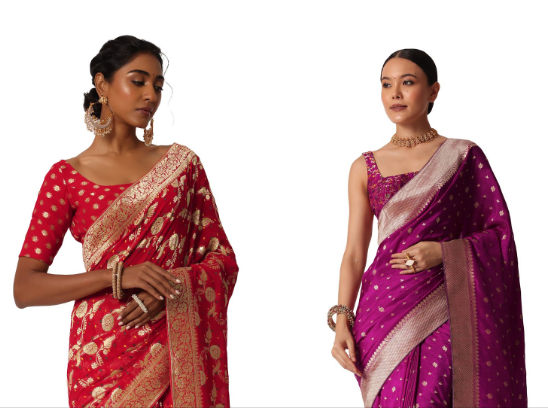Counterfeits are everywhere, which makes shopping for a Banarasi saree feel like guesswork. Photos are filtered, fabric names get muddled, and prices swing wildly for what looks like the same piece. If you love the look but worry about getting it wrong, here is a simple, shopper-friendly guide to help you feel sure before you click buy.
The Legacy of Banarasi Silk Sarees
Banarasi weaving comes from Varanasi, where Indian craftsmanship met Mughal influence and created brocades with a quiet kind of grandeur. A Banarasi saree usually has a pure silk base, such as katan or organza. They also feature zari work and motifs that carry stories, from kalga and bel to petite butis and sweeping jangla vines.
Beyond its heritage connection, a Banarasi silk saree has earned its rightful place in wedding wardrobes because it drapes beautifully. It highlights your presence in a crowd and in photographs. The pallu holds the shape it’s draped in, and the silhouette sparkles under the spotlight. The saree ages well with care. It is the piece you return to for big moments and later pass down with pride.
Common Problems While Buying Banarasi Sarees
- Dupes and machine-made imitations: Power-loom copies of a Banarasi saree often look a little too perfect. Motifs repeat with copy-paste precision, the surface reads flat, and the price seems unbelievably sweet.
- High price confusion: Pure Banarasi silk saree uses natural silk (usually katan, kora, or organza) with quality zari, which means that the prices are a little high. Sarees made of silk blend, art silk, or polyester mix fabric mean that they are not pure silk. So the prices should be lower.
- Misleading sellers online: Imitation sellers often crop product photos to hide the borders and the back of the saree, which can make it tricky to see the full design. The weave details are missing, and returns feel complicated. To ensure that you are purchasing authentic Banarasi silk sarees, ask for close-ups, videos in natural light, and a clear breakdown of fabric and zari before you commit.
How to Identify Pure Banarasi Silk Sarees
Weaving Technique – Handloom Versus Machine: Pure Banarasi silk sarees show a little life in the weave. If they aren’t original handloom pieces, you will be able to notice gentle irregularities, slightly uneven floats at the back, and a tactile change where motifs begin and end. Machine-made versions look identical line after line.
Fabric Touch, Zari Work, and Motifs: Pure Banarasi silk saree feels cool and smooth to the touch, with a soft, not glassy, sheen. Zari lines sit a bit raised and feel firm. Traditional motifs should be woven in, never printed or glued. If the design looks flat or the shine feels harsh, pause.
Hallmarks of Authenticity: Look at the product tage for the Silk Mark to confirm pure silk and a Varanasi GI mention to confirm it was woven in Varanasi. That’s how you know it is a true Banarasi. Reputable sellers name the silk type, zari type, and loom process on their invoices, and many will share short loom videos on request.
Checklist Before You Buy Online
- If you are purchasing a pure Banarasi silk saree online, read the fabric composition word for word. Terms like pure katan silk, kora silk, or organza silk are the types of fabric used to make these sarees.
- A pure Banarasi saree has clear tell-tale features. Zoom into borders, pallus, and the reverse to inspect floats and finishing.
- Ask for a natural-light video to see the drape, movement, and the tone of the zari.
- Authentic Banarasi silk sarees come with a Silk Mark certification. Confirm that it is available along with a fair return or exchange window in writing.
- Compare prices with trusted boutiques to understand a realistic range for handloom work.
- Skip heavy brocades offered with unbelievable discounts.
Note: The burn test that circulates online can damage your saree and is unsafe.
Wedding Special: Choosing the Right Banarasi Saree
Why Red Remains the Bridal Favorite
A red Banarasi silk saree speaks tradition, frames gold jewelry beautifully, and reads regal in photographs. Brides often choose to wear a red Banarasi saree for weddings as it is a traditional staple in indian weddings..
Styling Tips for Wedding Ceremonies
If you plan to wear a Banarasi saree for a wedding with a structured blouse, a sleek bun or braid, and temple jewelry that echoes the border. A velvet or silk potli adds texture, while clean makeup lets the weave do the talking.
Guest Styling Without the Weight
Choose a lighter Banarasi saree in kora, organza, or fine katan with petite butis and narrow borders. Jewel tones feel festive at night, soft pastels feel fresh for the day, and both keep the spotlight on the bride.
Where to Buy Authentic Banarasi Sarees Online
Shortlist specialist stores and designer-led boutiques that work with Varanasi clusters. Read reviews of stores that sell pure Banarasi silk sarees that speak to weave quality, finishing, and after-sales support.
Before purchasing a Banarasi saree online, check the high-resolution close-ups, a natural-light video, Silk Mark certification, and a clear return policy. Using secure payment gateways and keeping original bills always helps.. If you are buying from a new seller, go for a simple saree before you purchase a Banarasi saree for wedding wear.
A genuine Banarasi silk saree holds craft, culture, and celebration in every motif. Learn the hallmarks, ask for proof, and invest in a pure Banarasi saree so your wardrobe carries both tradition and quiet luxury for years to come.



